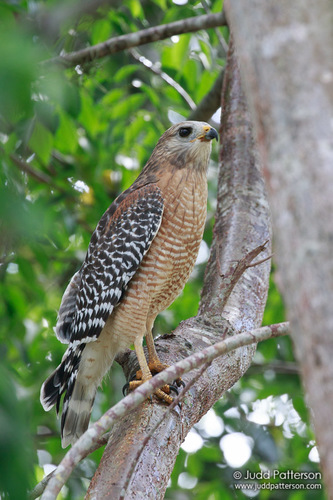
Red-shouldered Hawk
The Red-shouldered Hawk (Buteo lineatus) is a medium-sized raptor found throughout eastern North America and along the coast of California and northern Mexico. It's a bird of mature forests, often near water, where it plays a crucial role in controlling rodent and reptile populations. This hawk is easily recognized by its reddish barring on the breast and the distinctive black-and-white bands on its tail. While not currently considered globally threatened, habitat loss continues to be a concern for some populations. The Red-shouldered Hawk is less prominent in cultural symbolism compared to some other raptors, but its striking appearance and common presence in some areas have made it a familiar sight to many.
43-61 cm
Length
90-127 cm
Wingspan
Least Concern
Conservation Status
Distribution
The Red-shouldered Hawk has two main populations: one in eastern North America, ranging from southern Canada down to Florida and eastern Texas, and another along the Pacific coast, from northern California to Baja California. Some populations are resident year-round, while others, particularly those in the northern part of the range, migrate south for the winter. They are typically found at lower elevations.
Lifespan
In the wild, Red-shouldered Hawks can live up to 20 years, though the average lifespan is likely shorter. Captive individuals may live longer.
Red-shouldered Hawk's Habitat
Habitat Types
Mature deciduous forests, Mixed forests, Wooded wetlands, Riparian areas, Suburban areas with mature trees
Climate Zones
Temperate, Subtropical
Adaptations
Red-shouldered Hawks prefer areas with open understories for hunting, and tall trees for nesting. Their relatively broad wings and long tails are well-suited for maneuvering through forested environments. They often perch near water bodies, taking advantage of the abundant prey found there.
Variations
Five subspecies are generally recognized, differing slightly in size and coloration. For example, *B. l. extimus* found in Florida is smaller and paler than the nominate subspecies *B. l. lineatus*.
Appearance
Breeding Plumage
Adult plumage is relatively consistent year-round. Juveniles are browner overall, with streaked underparts, and lack the reddish shoulder patch.
Seasonal Feather Changes
Minimal seasonal variation in adult plumage.
Sex Based Plumage Differences
Males and females have similar plumage, although females tend to be slightly larger and may have slightly less vibrant reddish coloration.
Notable Features
Reddish 'shoulder' patch on the upper wing, Boldly barred reddish breast and belly, Black-and-white banded tail, Strong, hooked beak, Sharp talons
Diet and Feeding
Primary Foods
Small mammals (voles, mice, chipmunks), Reptiles (snakes, lizards), Amphibians (frogs, toads), Birds (small songbirds, occasionally), Crayfish and other large invertebrates
Foraging Behavior
Red-shouldered Hawks typically hunt from perches, scanning the ground for prey. They may also fly low over open areas or through the forest understory. They are known for their patient hunting style, often remaining still for extended periods before striking.
Specializations
Their sharp talons and strong beak are adaptations for capturing and consuming a variety of prey. Their keen eyesight allows them to spot prey from a distance.
Seasonal Diet Variations
Diet varies depending on prey availability. In winter, they may rely more heavily on small mammals, while in summer, amphibians and reptiles may form a larger part of their diet.
Behavior
Social Structure
Red-shouldered Hawks are generally solitary or found in pairs, especially during the breeding season. Outside of the breeding season, they may be more tolerant of other individuals, but are not typically considered social.
Communication
Loud, piercing 'kee-aah' calls, often repeated, Calls used for territorial defense and communication between mates, Visual displays, such as soaring and diving during courtship
Migration
Northern populations are migratory, moving south to the southern United States and Mexico for the winter. Southern populations are generally resident year-round. Migration typically occurs in the fall (September-November) and spring (March-May).
Territorial or Group Behaviors
Red-shouldered Hawks are strongly territorial during the breeding season, defending their nesting territory against other hawks and potential predators. They are known for their aggressive defense of the nest.
Conservation
Threats
Habitat loss and fragmentation (due to deforestation and development), Pesticide exposure (through contaminated prey), Collisions with vehicles, Climate change (potential impacts on prey availability and habitat suitability)
Protection Programs
Migratory Bird Treaty Act (protects the species in the United States), State-level protections (vary by state), Habitat conservation and restoration efforts
Local National Laws
Protected under the Migratory Bird Treaty Act in the United States.
Population Trend
Stable
Population Estimates
The global population is estimated to be around 1.1 million individuals.
Interesting Facts
Red-shouldered Hawks often reuse the same nest year after year.
They may add to the nest each year, resulting in large structures over time.
They are known for their loud, distinctive calls.
These calls are often heard before the hawk is seen, and are a common sound in their woodland habitat.
They have excellent eyesight.
Like all raptors, they rely on keen vision to locate prey.
They sometimes cache, or hide, excess food.
This is a common behavior in many raptor species, allowing them to store food for later consumption.
The oldest known Red-shouldered Hawk lived to be at least 25 years and 10 months old.
This individual was banded as a nestling and later recovered.
Faqs about Red-shouldered Hawk
What do Red-shouldered Hawks eat?
They eat a variety of small animals, including rodents, reptiles, amphibians, birds, and large invertebrates.
Where do Red-shouldered Hawks live?
They are found in mature forests, often near water, in eastern North America and along the Pacific coast.
Are Red-shouldered Hawks endangered?
No, they are classified as Least Concern by the IUCN, meaning they are not currently considered to be at risk of extinction.
How can I tell a Red-shouldered Hawk from other hawks?
Look for the reddish barring on the breast, the black-and-white banded tail, and the reddish 'shoulder' patch on the upper wing.
Do Red-shouldered Hawks migrate?
Northern populations migrate south for the winter, while southern populations are generally resident year-round.
Copyright @ Nature Style Limited. All Rights Reserved.
 English
English